|
Related FAQs: Rays, Skates, Batoids 2, Batoid Identification, Batoid Behavior, Batoid Compatibility, Batoid Selection, Batoid Systems, Batoid Feeding, Batoid Disease, Batoid Reproduction, Shark, Ray Eggs,
Freshwater Stingrays: FW
Stingray Identification, FW Stingray Behavior,
FW Stingray
Compatibility, FW
Stingray Selection, FW Stingray Systems,
FW Stingray Feeding,
FW Stingray
Disease, Sharks/Rays &
Crypt, FW Stingray
Reproduction,
Related Articles: Saltwater
Ray Husbandry By Adam Blundell,
Sharks,
Freshwater Stingrays,
Wounds
Articles,
/The Conscientious Marine
Aquarist
Rays and their
Relatives. Batoids For The Home Aquarium?
|
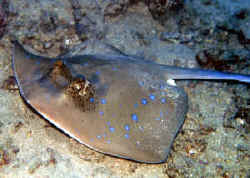
|
|
Bob Fenner
|
Dasyatis kuhlii
in Australia
|
Survey piece to be penned... Review here of more commonly seen,
offered species, husbandry notes.
 |
Sharks and Rays in Aquariums
Gaining an understanding of how to keep these fishes in captive
saltwater systems
New
Print and
eBook on Amazon
by Robert (Bob) Fenner |
 |
Stingrays, family Dasyatidae: Marine, brackish, freshwater
(the subfamily Potamotrygonidae, which I have as a
family here). Atlantic, Pacific and Indian Oceans. Nine genera, 69
species. To distinguish from the Round Stingrays, no caudal fin, tail
longer than body, body disc more than 1.3 times as wide as long.
| Dasyatis americana (Hildebrand &
Schroeder 1928), the Southern Stingray. Western Atlantic; New
Jersey to Brazil. To over six feet in diameter. Below: A full and
business end view of a specimen in Tobago in the Lower Antilles and
one in the Bahamas. |
| Dasyatis kuhlii (Muller & Henle 1841),
Kuhl's or the Blue-Spotted Stingray. Indo-West Pacific,
including the Red Sea. To twenty eight inches in width. Reef
associated. Feeds on crustaceans (shrimps and crabs mainly).
Venomous. One off Heron Island, Australia, and a smaller individual
in N. Sulawesi (Lembeh Strait). |
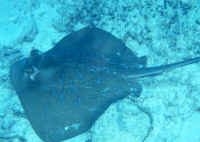
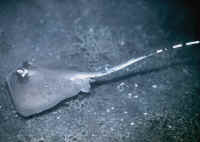
|
Bigger PIX:
The images in this table are linked
to large (desktop size) copies. Click on "framed" images
to go to the larger size. |
|
%20MD.JPG)
|
| Dasyatis pastinaca (Linnaeus 1758), the
Common Stingray. Northeast Atlantic and Mediterranean. To about two
feet in diameter. London Aquarium image. |
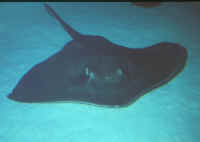
|
| Himantura jenkinsii (Annondale 1909),
Jenkins Whipray. Indo-Pacific; South Africa to Northern Australia.
To a meter in width. This female showing the characteristic ridge
of denticle spines off Redang, Malaysia. |
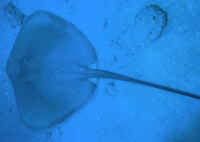
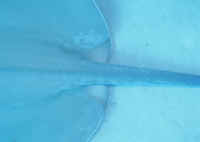 |
Eagle and Bat Rays, family Myliobatidae: Atlantic, Indian and
Pacific. Heads elevated above body discs. Very long tails. Five genera,
43 species.
Bigger PIX:
The images in this table are linked to large
(desktop size) copies. Click on "framed" images to go to
the larger size. |
|

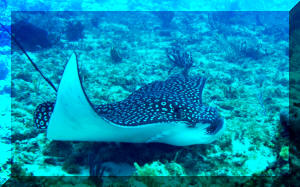
|
| Manta birostris (Donndorff 1798), a/the
Manta Ray. The paddle-like extensions on the head used for
directing food into this filter feeders mouth. Third largest fish
species at more than 6.7 meters in width, two tons in weight.
Circumtropical. One at a cleaning station in Australia, another in
Hawai'i in shallow water shot by MikeK. |
 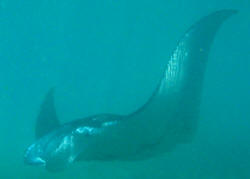
|
| Myliobatis californica Gill 1865, the Bat
Eagle Ray. Eastern Pacific, Oregon to the Galapagos Islands. To
more than five feet in diameter. This cool water species is
occasionally offered for sale as an aquarium fish... it's not,
unless you have a swimming-pool size system. This one in the
Aquarium of the Pacific, Long Beach, California. |
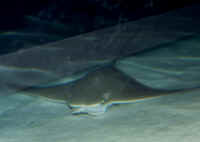
|
Cownose Rays: family Rhinopteridae. Some writers place this
as a subfamily (Rhinopterinae) within the Myliobatidae.
Round Stingrays, family Urolophidae: Western Atlantic,
eastern Indian and Pacific. Four genera, 37 species. Body disc less
than 1.3 times width. Have caudal fins on moderately long tails. Some
now in the Urotrygonidae: http://en.wikipedia.org/wiki/Urotrygonidae
| Taeniura lymna (Forsskal 1775), the
Bluespotted Ribbontail Ray (3) (aka the Bluespotted Stingray in the
pet-fish trade). Indo-West Pacific, including the Red Sea. To
fourteen inches in width. A commonly offered species in the
ornamental marine interest, but rarely lives... due to shipping
trauma, being kept in too-small quarters, lack of oxygen, scratches
and subsequent infections... An aquarium and Red Sea specimen
shown. |

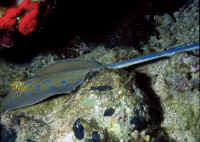 |
| Urobatis (Urolophus) halleri
(Cooper 1863), the California, Haller's Round Stingray (3). Eastern
Pacific, California to Panama. To more than two feet in diameter.
Another cool water species occasionally caught and offered in the
aquarium trade out of California... One in the Sea of Cortez off of Mulege, Baja, California, another at a wholesalers in Los
Angeles. |
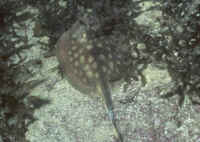
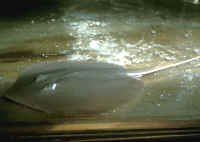
|
Bigger PIX:
The images in this table are linked to large
(desktop size) copies. Click on "framed" images to go to
the larger size. |
|
%20MD.JPG)
%20MD.JPG)
|
| Urobatis (Urolophus) jamaicensis (Cuvier 1816), the
Yellow Stingray. Western Atlantic; North Carolina to Venezuela. To
thirty inches wide. Aquarium and Cozumel photos. Below w/ a
Caranx ruber in Cozumel 2011. |
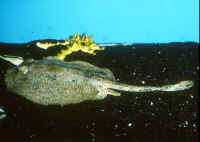
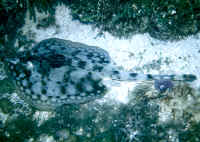
|
| Verticals (Full/Cover Page Sizes
Available) |

%20MD.JPG) |
Electric/Torpedo Rays, family Torpedinidae: Two genera,
fourteen species; all marine. Atlantic, Pacific and Indian Oceans.
Distinguished by pancake-like appearance and substantial electric shock
they can/do produce to deter predators, stun prey.
Bigger PIX:
The images in this table are
linked to large (desktop size) copies. Click on "framed"
images to go to the larger size. |
%20MD.JPG)
%20MD.JPG)
%20MD.JPG) |
| Torpedo sinuspersici Olfers 1831, Marbled
Electric Ray. Western Indian Ocean; Red Sea, East Africa to India.
To 130 cm. in length. Red Sea image. |
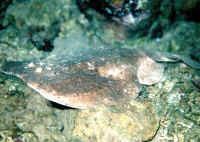
|
Bigger PIX:
The images in this table are
linked to large (desktop size) copies. Click on "framed"
images to go to the larger size. |
|
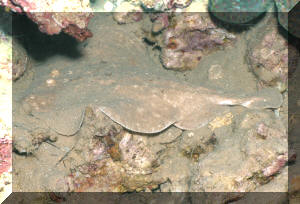
|
Guitarfishes, family Rhinobatidae: Looking like
intermediaries between the Sharks and more "ray-like"
cartilaginous fishes,
| Rhinobatos productus Ayres 1854, the
Shovelnose Guitarfish. Eastern Pacific; Californias, US, Mexico. To
about five feet total length, 18kg weight. A cool to coldwater Ray
that is too often offered in the aquarium interest as a
tropical. |
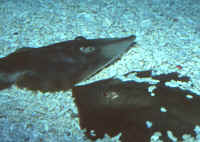
|
| Trygonorrhina fasciata Muller & Henle
1841, the Southern Fiddler. Eastern Indian Ocean; Australian
endemic. To more than four feet in length, 6.7 kg. Aquarium
image. |
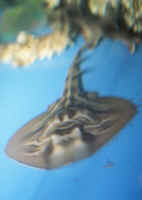
|
| Zapteryx exasperata (Jordan & Gilbert
1880), the Banded Guitarfish. Eastern Pacific; California to Peru.
Rocky reefs, rarely buried in sand. To three feet in length. Cabo
San Lucas photo. |
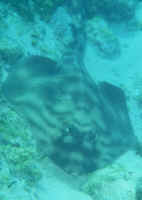
|
Thornback Rays, family Platyrhinidae;
| Platyrhinoidis triseriata (Jordan &
Gilbert 1880), the Thornback Guitarfish. Eastern Pacific, San
Francisco to Mexico's Baja. To three feet in length. Aquarium
images. |
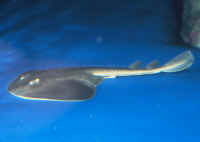 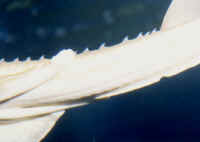
|
Skates, family Rajidae: Found in all Oceans. Eighteen genera,
224 species. Slender tails with rows of denticles on their surface,
often these animals backs have a row as well. Eggs in horny cases with
four long tips.
| Raja eglantiera Bosc 1800, the Clearnose
Skate. Western Atlantic; Massachusetts to the Gulf of Mexico. To
two feet in diameter. This one in the shallows in the Bahamas. |
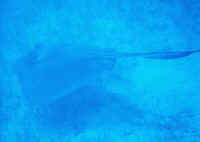
|
| And a neat demonstration... a skate egg with a
"window" cut in it and a piece of acetate secured for
easy viewing of the developing youngster within. Pic made at
Monterey Bay Aquarium. |
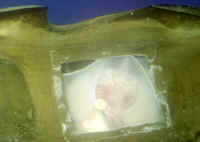
|
Captive Care:
| Re: Goiter: A common cause of nutritional
deficiency syndrome is goiter in cartilaginous fishes <Note the
bulge/growth in the area just below the mouth>... Here's an
afflicted ray being properly offered food that is iodine/ate
enriched. |
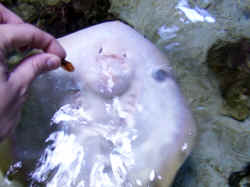
|
Bibliography/Further Reading:
 |
Sharks and Rays in Aquariums
Gaining an understanding of how to keep these fishes in captive
saltwater systems
New
Print and
eBook on Amazon
by Robert (Bob) Fenner |
 |
Dahlstrom, Joni. 1987. Torpedo Ray. The sea's shocking surprise
package. Skin Diver 6/87.
Debelius, Helmut. 1978. The Blue-Spotted Stingray. TFH 10/78.
Donovan, Paul. 1997. Electric Rays. TFH 11/97.
Edmonds, Les. 1989. Stingrays in the aquarium. TFH 6/89.
Hargrove, Mic. 1998. Tank busting Batoids. MFM 8/98.
Michael, Scott. 1996. Beware of Bluespots. A bluespotted beauty that
should be left on the reef. AFM 1/96.
Zimmer, Carl. 1999. The mystery of the Mermaid's Purse. The egg
case of the Hedgehog Skate provides more than a safe environment.
Natural History. 7-8/99.
|
|

